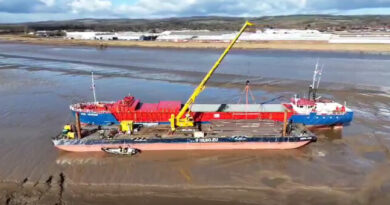BAE Systems Boosts Shipbuilding Capacity for Frigates with Massive New Hall
Defense contractor BAE Systems is expanding on Scotland’s rich tradition of shipbuilding and advancing the future of the industry by opening a new assembly and outfit hall in Glasgow. The unique facility will contribute to ensuring the timely delivery of the next generation of warships for the UK’s Royal Navy.
The new facility is part of a £300 million ($411 million) modernization and digitalization of BAE Systems’ operations in Glasgow. It is named Janet Harvey Hall in honor of a World War II female shipyard electrician and offers the capacity for the construction of two Type 26 frigates side-by-side.
Notably, the facility is designed to accommodate up to 500 workers per shift, something that will boost BAE Systems’ shipbuilding capacity by enabling warships to be built in Glasgow fully undercover for the first time. It ensures that work is unaffected by adverse weather. Essentially, the hall will help improve schedule performance and reduce the time between ship deliveries.
BAE Systems contends the new facility will be a strategic part of the program to construct eight Type 26 frigates for the Royal Navy. At 170 meters long and 80 meters wide (558 x 262 feet), with two 100-tonne cranes and a further two 20-tonne cranes inside, the hall is not only large enough but is also well equipped to handle the building of two frigates side-by-side.
“The Janet Harvey Hall brings an improved approach to warship assembly and outfit, driving quality throughout the build, and this approach supports regular delivery of vessels in line with the Royal Navy’s need,” said Stephen Charlick, Type 26 Resident Project Officer.

The enclosed space can be used to build two frigates simultaneously (BAE)
Described as one of the world’s most advanced warships, the Type 26 frigates are designed for anti-submarine warfare and high-intensity air defense. They can also adapt their roles quickly to transport high volumes of humanitarian aid and house medical facilities. The ships will replace the aging Type 23 fleet.
Currently, the HMS Belfast and Birmingham are being built in the hall while Glasgow and Cardiff are being outfitted at the Scotstoun site further up the River Clyde. Steel has also been cut on the fifth ship, Sheffield. Building of the ships is expected to sustain approximately 1,700 jobs in Scotland and an additional 2,300 jobs across the wider UK supply chain.
Comprised of eight ships in total, the Type 26 frigates are expected to enter service in the coming years, with the first three (Glasgow, Cardiff, and Belfast) being delivered before 2030. The other five ships will join the fleet after 2030. They will have the capacity to accommodate a crew of 208.




